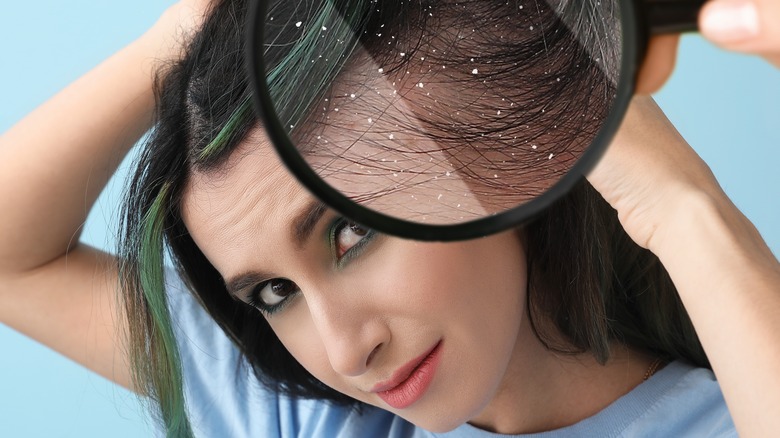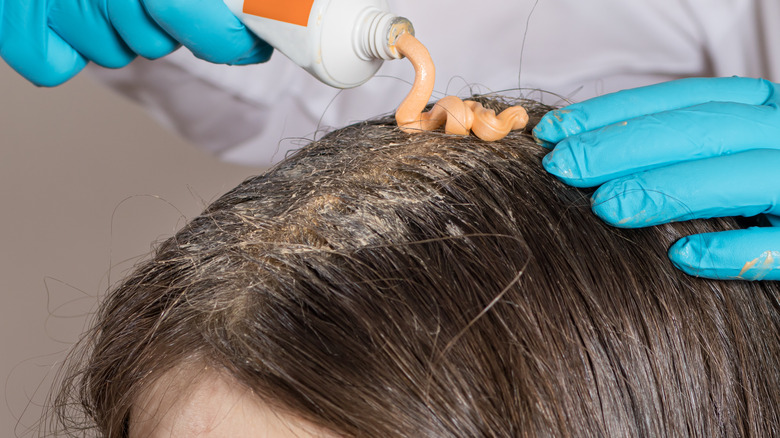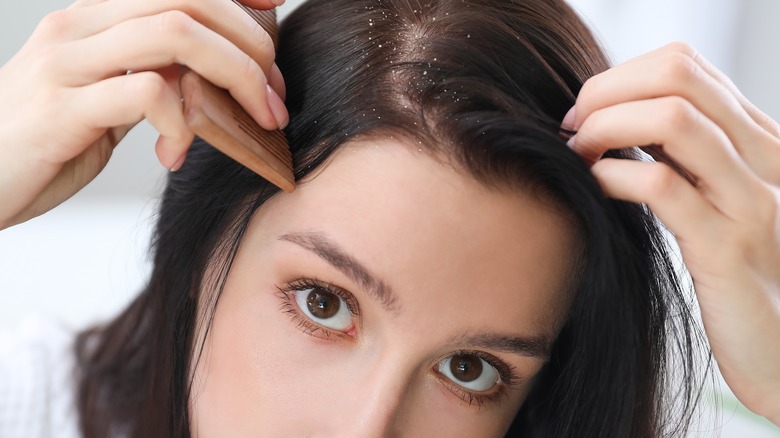What Is Scalp Malassezia And How Can You Treat It?
What does a bad hair day look like for you? Does your fluffy pixie look like it's been swept apart in a raging wind? Or do your flat-ironed tresses get so frizzy and dry that no amount of leave-in conditioner can tame them? For many, a bad hair day is as simple as having a scalp so itchy and bumpy that when they scratch it, flakes as white as snow cascade down their locks and perch on their clothing. Unfortunately, these episodes of poor hair usually persist for more than a day and require treatment. Dandruff affects approximately 50% of adults globally, per Unilever. Beginning in young adulthood, dandruff can continue through middle age if left untreated.
Contrary to the popular belief that dandruff has to do with how often you wash your hair, it actually has more to do with your scalp health and should be seen as a skin condition, per WebMD. So, is dandruff some sort of fungus? Actually, it isn't. Instead, it's the product of a fungus known as Malassezia — the main culprit for your irritating scalp and flaky dandruff. Here's everything to know about Malassezia and how you can get rid of it.
What is scalp Malassezia
According to Head & Shoulders, Malassezia, a part of the scalp microbiome, is a fungus that dwells on everyone's skin and is responsible for causing dandruff along with a slew of other issues, such as allergies and infections. So technically, dandruff is not a fungal infection but rather a product of one.
People who live in hot, humid climates or sweat a lot, those with diabetes, oily skin, weakened immune systems, and those who use antibiotics and steroids are more likely to be affected by this problem, per Cleveland Clinic. Additionally, those who have dandruff or seborrheic dermatitis are more likely to develop Malassezia.
Malassezia feeds on saturated fatty acids found in sebum, meaning that an oily, sweaty scalp makes a perfect breeding ground for this fungus. The overgrowth of Malassezia can disturb natural skin cell turnover, causing scalp cells to cluster together and appear as dandruff as well as seborrheic dermatitis, an inflamed, flaking, and scaling skin condition that spreads from the scalp to the face and the chest. Therefore, treatments intended to stamp out dandruff usually incorporate anti-fungal ingredients formulated to eradicate Malassezia. If left untreated, the condition can cause hair breakage and hair thinning.
Inconvenience aside, dandruff can also lead to a lack of self-esteem as many who suffer from chronic dandruff may feel that people may think of them as lacking personal hygiene. Therefore, it's important to treat the imbalance in the scalp and prevent further fungal infection.
Treatment of Malassezia
DermNet states that antifungal medications, such as fluconazole or ketoconazole shampoo, can be used as your first-line treatment. Topical steroids are another option for treating seborrheic dermatitis, and many patients have been effectively treated with oral pulse itraconazole. Selenium sulfide and zinc pyrithione are often prescribed to help treat the underlying infection, while products containing salicylic acid are effective against dandruff (via Healthline).
If you have itchy breakouts on your scalp or a dandruff problem, switch from regular or dry shampoo to scalp-targeted, anti-dandruff shampoo to remove excess sebum and product buildup while soothing your irritated scalp. You can also nourish your hair and scalp using hair oil or serum containing pH-balancing, anti-fungal elements such as tea tree oil, aloe, apple cider vinegar, colloidal oat, and willow bark. At the same time, steer clear of potential triggers such as perfume, sodium lauryl sulfate (SLS), sodium laureth sulfate (SLES), diethanolamine, and butylparaben. Hair dye can also be a trigger for Malassezia, so it's best to use hair products that don't include ammonia and hydrogen peroxide to avoid aggravating your scalp and hair follicles (via Loved by Curls). And, if at all possible, avoid letting the dye sit on your scalp to prevent it from drying out.


